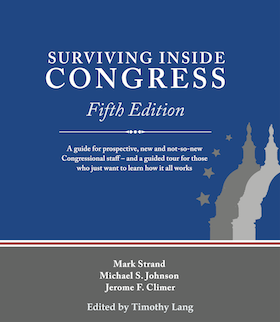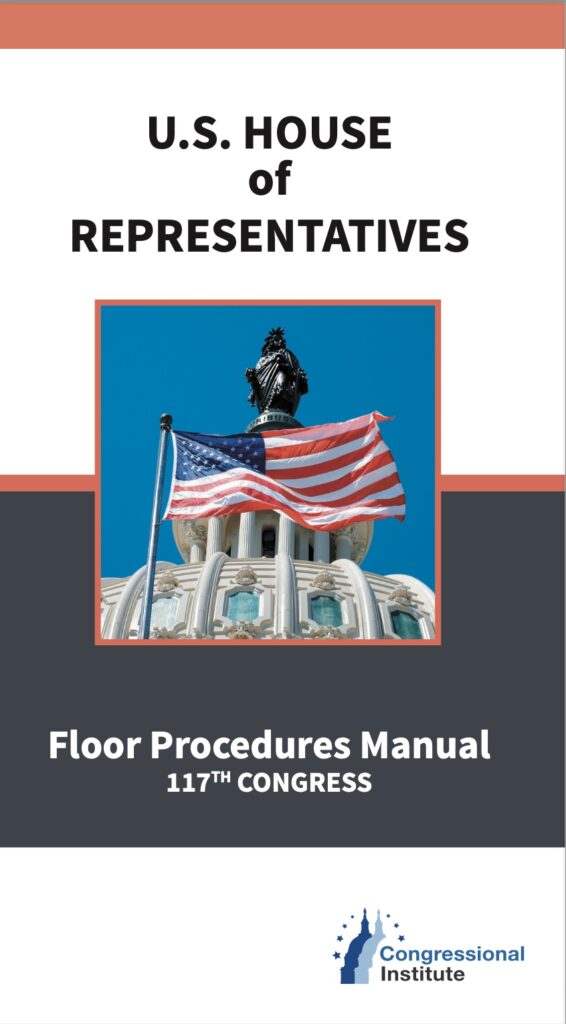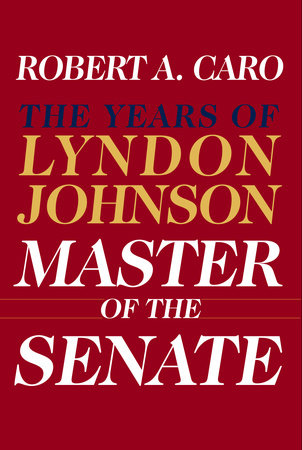Christmas is nigh upon us, and many will undoubtedly be looking for gift ideas or suggestions for reading over the holiday break. Why not read a little about Congress? We’ve put together a list of congressional books that you or your friends or family might enjoy.
Congressional Procedure and Process
Surviving Inside Congress, 5th Edition
Mark Strand, Michael S. Johnson & Jerome F. Climer
Congressional Institute
Surviving Inside Congress, the Congressional Institute’s signature publication, is a guide to how Congress operates for Members of Congress, current and prospective congressional staff, and anyone else interested in the Legislative Branch. It explains various issues such as the staff positions, the committee process, the basics of Floor procedure and legislative tactics, congressional ethics, polarization and partisanship, and much more. The Congressional Institute provides free copies to Members of Congress and staff.
Copies may be purchased directly from the Congressional Institute website.

Congressional Procedure: A Practical Guide to the Legislative Process in the U.S. Congress
Richard A. Arenberg
Arenberg, who served for many years as a Senate staffer, offers an introduction to the legislative process starting with the Constitution and ending with the President’s veto or signature. Along the way, he shows the reader congressional committees, the differences between the House and Senate, how the two Chambers resolve their differences, and many other issues. Also covered are additional congressional powers and responsibilities, such as the Senate’s confirmation process and treaty ratifications. The book is excellently organized and illustrates concepts with plenty of diagrams as well.
(In addition to Arenberg’s Congressional Procedure, readers should also read his Defending the Filibuster: The Soul of the Senate, co-authored with former Senate Parliamentarian Robert B. Dove. As the title unabashedly proclaims, it is an apologia for the Senate’s filibuster, and one of the best at that.)
Congressional Procedures and the Policy Process, 11th Edition
Walter J. Oleszek, Mark J. Oleszek, Elizabeth E. Rybicki, William Alan Heniff
Written by staff of the Congressional Research Service, Congress’ in-house think tank, this book covers the legislative process in-depth. One particular advantage is that the authors treat the congressional budget process early in the book, which is an important editorial decision since the budget affects nearly every aspect of the legislative process and very many of the country’s most difficult-to-resolve policy issues. Now in its 11th edition, the book has been updated frequently to reflect the contemporary Congress accurately.
Setting Course: A Congressional Management Guide
Congressional Management Foundation
Setting Course, published by the Congressional Management Foundation, provides extensive nuts-and-bolts guidance on establishing and maintaining a congressional office. Divided into three parts, it offers advice for everyone from Members-elect to long-serving veterans. It covers various issues including budgeting for an office, internal and external communications, strategic planning, how to hire staff, and many others.
U.S. House of Representatives Floor Procedures Manual
Congressional Institute
The U.S. House of Representatives Floor Procedures Manual is an easy-to-understand guide to debate on the Floor of the House of Representatives. It explains issues like the House’s daily schedule, how bills come to the Floor, how to offer an amendment, and how to obtain time to speak. Staff from the House Rules Committee update it at the beginning of each Congress. Small enough to fit into a pocket, Members and staff can easily carry it with them to the Chamber and refer to it during debate. The Congressional Institute provides free copies to Members of Congress and staff. Members and staff may request a copy by sending an email from their official email account to book@conginst.org.
The Congressional Institute also publishes the Floor Procedures Manual on its website: House Floor Procedures Manual Digital Edition

House Practice: A Guide to the Rules, Precedents, and Procedures of the House
Charles W. Johnson, John V. Sullivan, Thomas J. Wickham, Jr.
Written by the Parliamentarians of the House, House Practice is a one-volume distillation of the Chamber’s parliamentary procedure. The subtitle’s reference to itself as a “guide” to House procedure is accurate, though in this case, the term should not be construed to connote “simple” or “basic.” It’s a beefy book, and those new to procedure would do well to read through a more introductory work, such as Surviving Inside Congress or the House Floor Procedures Manual, first. Once a person has a more basic introduction to House procedure, he or she can really benefit from this work, since it delves more fully into the details of the rules and precedents, and attention to parliamentary details is indispensable to legislating effectively.
Senate Procedure and Practice, Fourth Edition
Martin B. Gold
Written by veteran Senate staffer Martin B. Gold, Senate Procedure and Practice is an excellent introduction to how the Senate operates. Gold offers a readable, yet comprehensive, explanation of various aspects of the Senate, including debate on the Floor, committee procedure, and the budget process. One particularly useful aspect of this book is its extensive case studies that illustrate how the Senate operates today.
How Our Laws Are Made
John V. Sullivan
The name says it all. First drafted by the House Judiciary Committee and updated by the former Parliamentarian of the House, this pamphlet explains how Congress enacts a bill. In addition to that, it explains other topics such as the terms and elections of Representatives and Senators, oversight of the Executive Branch, and how laws are published and codified. Clocking in at fewer than 70 pages, it’s a manageable intro to the legislative process. It also has the distinction of being published pursuant to a vote of the House and Senate, making it an official publication of the U.S. Federal Government.
Though printed copies of How Our Laws Are Made are available for purchase, a PDF is available online for free: How Our Laws Are Made.
Congressional History
The House: The History of the House of Representatives
Robert V. Remini
The House is the definitive one-volume history of the U.S. House of Representatives, covering everything from first days of the Federal Government to the early 2000s. Robert Remini, author of an acclaimed biography on Henry Clay, the first of the truly dominant House Speakers, introduces the reader to the most critical figures in the Chamber’s history, including Clay, Thaddeus Stevens, Thomas “Czar” Reed, Sam Rayburn, and Newt Gingrich. Likewise, he treats the most consequential laws in American history, such as the New Deal legislation and the Civil Rights Act of 1964. Additionally, he discusses less visible trends, such as the growth of the seniority system and congressional reform efforts. Aside from being a comprehensive history of the House, it is also an official history, having been written and published pursuant to the History of the House Awareness and Preservation Act (Public Law 106-99). It is a highly engaging read and an excellent introduction to the House’s storied history.
Kings of the Hill: How Nine Powerful Men Changed the Course of American History
Richard B. Cheney and Lynne V. Cheney
On the day Newt Gingrich was sworn in as Speaker, Rich Galen, one of his staffers recalled asking how many fellow GOP Members thought they could be Speaker that day, if only they had “killed his political career” a decade earlier. None, Gingrich responded. “This is a meritocracy and they know I’m the only one that could have gotten them here.”
Gingrich may have overstated his case, but a determined and skilled individual can do much to reshape the institution. The men that former Vice President Dick Cheney and Lynne Cheney profile left their mark on both the House and the nation, each serving as a reminder of the power of an individual. They also serve as a reminder of a person’s limitations. For instance, Speaker Tom Reed departed public life when he found himself out of step with his party’s position on war and national expansion. Likewise, Speaker Joe Cannon’s overbearing control of the legislative process led to a parliamentary revolt on the House Floor which he lost. Doubtless the Cheneys have a special insight into the ability of Members to shape their institution, as Dick Cheney served in the House from 1979 to 1989, a tenure that included service as Chair of the House Republican Conference and Republican Whip. Cheney left Congress to serve as Secretary of Defense under President George H.W. Bush, and was succeeded as Republican Whip by Newt Gingrich, whom he profiles in the book. All in all, it is a delightful introduction to the House’s most eminent figures.
A History of the Committee on Rules
U.S. House Committee on Rules
The House Committee on Rules is often described as the most powerful committee in Congress you’ve never heard of. Also known as “the Speaker’s Committee,” the panel reviews legislation and determines the terms of debate, including how long the House will debate and what amendments may be considered. Its role has evolved over the years from being an ad hoc committee; to a personal plaything of its Chair, the Speaker; to an independent power center; and back to where it is today, as an arm of the House majority leadership (albeit sans the Speaker as Chair). This book explores that story and discusses the role the Committee plays in the contemporary Congress. The Rules Committee prepared this history under the Chairmanship of Representative Richard Bollling, a legendary congressional reformer and procedural expert. Bolling was particularly notable for being one of the House’s most influential, ambitious and skilled legislators never to be Speaker—which he once lamented in a column, “Learn From My Losses How Not to Run for Speaker.” Now out of print, it will be hard to get ahold of these days, but well worth it.
Master of the Senate: The Years of Lyndon Johnson
Robert A. Caro
Prior to serving as President and Vice President under John F. Kennedy, Lyndon B. Johnson was a U.S. Senator from 1949 through 1961, with a stint as leader of the Democrats from 1953 until he left the Chamber. Without a doubt, he was one of the most effective party leaders in Senate history, becoming famous for what is now called “The Treatment,” an unusually effective and varied set of persuasive tactics that included invading someone’s personal space. Caro explains how Johnson won over a conflicting Senators to transform the Senate from a hoary, tradition-bound institution to a legislative dynamo. He situates Johnson’s triumphs in the broad sweep of the Senate’s—and America’s—history, from its earliest days to the 20th century. Nor does he omit small details in favor of the big picture: In one of the first pages of the book, he notes that the Senate desks were made in 1819 and that Daniel Webster laid his hand on one during his famed Second Reply to Hayne speech. If the reader can’t get enough LBJ from Master of the Senate, they need not fear as it is but the third volume of a yet-to-be-completed, exhaustive series on the 36th President of the United States.

Congressional Memoirs
Man of the House: The Life and Political Memoirs of Speaker Tip O’Neill
Tip O’Neill with William Novak
More than a few former Speakers of the House have written their memoirs after having departed public office. Man of the House, written by Tip O’Neill, who served as Speaker from 1977 to 1987, stands as one of the most memorable and enjoyable. O’Neill is remembered as a staunch Democrat who nonetheless developed a friendship with GOP President Ronald Reagan and House Republican Leader Bob Michel. Known for his wit and back-slapping style, O’Neill was famed for his dictum “All politics is local,” which stresses the close relationship a Member should have with his or her constituents.
On the House: A Washington Memoir
John Boehner
The latest memoir to be written by a former Speaker, On the House by John Boehner will likely draw laughs—unless the reader is one of those being skewered by the former Republican leader. Boehner sketches his life, from growing up working in his father’s bar in Cincinnati, Ohio (a fact he’ll never let anyone forget), to his leadership of an exuberant and sometimes fractious House Republican Conference. Though the memoir is filled with numerous memorable anecdotes and turns of phrases, Speaker Boehner does not simply seek to entertain: He warns that elements of the Republican Party and media establishment have gone off the rails. Oh, and, in addition to getting the print edition, get the audiobook, since Boehner reads it himself. It’s almost impossible to imagine taking in this memoir any other way.

Christmas-Themed Books
All American Christmas
Rachel Campos-Duffy and Sean Duffy
In this book, several Fox News personalities share their memories of Christmas and their insights into the meaning of the holiday. All American Christmas is definitely not about Congress, but deserves an honorable mention as the work of a congressional couple. Congressman Sean Duffy served as a U.S. Representative from the state of Wisconsin from 2011 through 2019.
One Christmas in Washington
David J. Bercuson, Holger H. Herwig
On December 22, 1941, British Prime Minister arrived in the United States with a simple goal: Map out a plan to win World War II with American President Franklin Delano Roosevelt. One Christmas in Washington, written by Canadian military historians David Bercuson and Holger Herwig, tells the tale of how the two leaders, who shared a warm relationship, forged a working alliance despite logistical challenges and personality conflicts between persons on both sides. And while in Washington, on December 26, Churchill addressed a joint session of Congress, an appeal to Americans to support the war effort. As he wrote it the previous day at the White House, you might even consider it his Christmas gift to the American people.